
Film stock is an analog medium that is used for recording motion pictures or animation. It is recorded on by a movie camera, developed, edited, and projected onto a screen using a movie projector. It is a strip or sheet of transparent plastic film base coated on one side with a gelatin emulsion containing microscopically small light-sensitive silver halide crystals. The sizes and other characteristics of the crystals determine the sensitivity, contrast and resolution of the film. The emulsion will gradually darken if left exposed to light, but the process is too slow and incomplete to be of any practical use. Instead, a very short exposure to the image formed by a camera lens is used to produce only a very slight chemical change, proportional to the amount of light absorbed by each crystal. This creates an invisible latent image in the emulsion, which can be chemically developed into a visible photograph. In addition to visible light, all films are sensitive to X-rays and high-energy particles. Most are at least slightly sensitive to invisible ultraviolet (UV) light. Some special-purpose films are sensitive into the infrared (IR) region of the spectrum.

A camera is an optical instrument that captures images. Most cameras can capture 2D images, while some more advanced models can capture 3D images. At a basic level, most cameras consist of a sealed box, with a small hole that allows light to pass through and capture an image on a light-sensitive surface. Cameras have various mechanisms to control how light falls onto the light-sensitive surface, including lenses that focus the light and a shutter that determines the amount of time the photosensitive surface is exposed to the light.

135 film, more popularly referred to as 35 mm film or 35 mm, is a format of photographic film used for still photography. It is a film with a film gauge of 35 mm (1.4 in) loaded into a standardized type of magazine – also referred to as a cassette or cartridge – for use in 135 film cameras. The engineering standard for this film is controlled by ISO 1007 titled '135-size film and magazine'.

120 is a film format for still photography introduced by Kodak for their Brownie No. 2 in 1901. It was originally intended for amateur photography but was later superseded in this role by 135 film. 120 film survives to this day as the only medium format film that is readily available to both professionals and amateur enthusiasts.
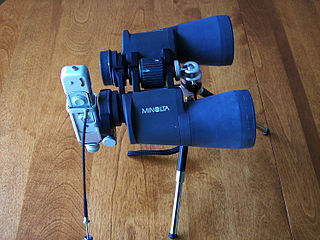
Minox is a manufacturer of cameras, known especially for its subminiature camera.
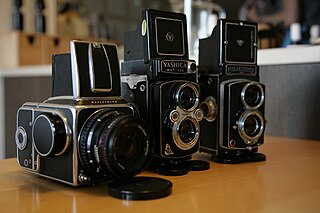
Medium format has traditionally referred to a film format in photography and the related cameras and equipment that use film. Nowadays, the term applies to film and digital cameras that record images on media larger than the 24 mm × 36 mm used in 35 mm photography, but smaller than 4 in × 5 in.
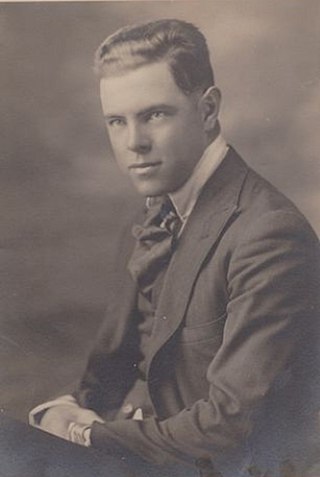
Photographic processing or photographic development is the chemical means by which photographic film or paper is treated after photographic exposure to produce a negative or positive image. Photographic processing transforms the latent image into a visible image, makes this permanent and renders it insensitive to light.
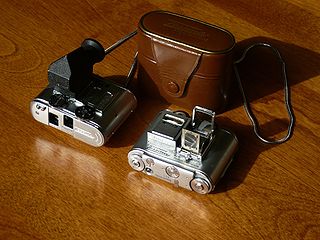
Subminiature photography is photographic technologies and techniques working with film material smaller in size than 35mm film, such as 16mm, 9.5mm, 17mm, or 17.5mm films. It is distinct from photomicrography, photographing microscopic subjects with a camera which is not particularly small.

The Holga is a medium format 120 film camera, made in Hong Kong, known for its low-fidelity aesthetic.
Sheet film is large format and medium format photographic film supplied on individual sheets of acetate or polyester film base rather than rolls. Sheet film was initially supplied as an alternative to glass plates. The most popular size measures 100 mm × 130 mm ; smaller and larger sizes including the gigantic 510 mm × 610 mm have been made and many are still available today.
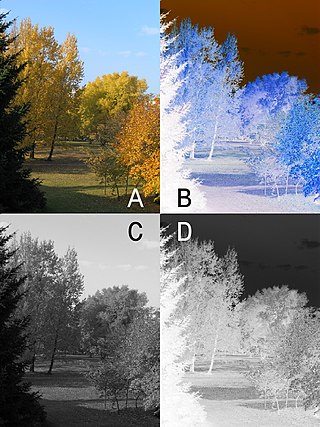
In photography, a negative is an image, usually on a strip or sheet of transparent plastic film, in which the lightest areas of the photographed subject appear darkest and the darkest areas appear lightest. This reversed order occurs because the extremely light-sensitive chemicals a camera film must use to capture an image quickly enough for ordinary picture-taking are darkened, rather than bleached, by exposure to light and subsequent photographic processing.

A darkroom is used to process photographic film, to make prints and to carry out other associated tasks. It is a room that can be made completely dark to allow the processing of the light-sensitive photographic materials, including film and photographic paper. Various equipment is used in the darkroom, including an enlarger, baths containing chemicals, and running water.

A contact print is a photographic image produced from film; sometimes from a film negative, and sometimes from a film positive or paper negative. In a darkroom an exposed and developed piece of film or photographic paper is placed emulsion side down, in contact with a piece of photographic paper, light is briefly shone through the negative or paper and then the paper is developed to reveal the final print.

Canister shot is a kind of anti-personnel artillery ammunition. Canister shot has been used since the advent of gunpowder-firing artillery in Western armies. However, canister shot saw particularly frequent use on land and at sea in the various wars of the 18th and 19th century. Canister is still used today in modern artillery.
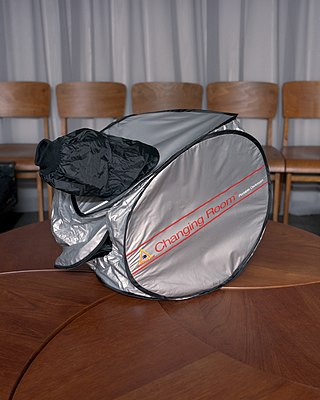
A changing bag is a photographic bag specifically designed to be light-proof while in use. It is required for certain applications involving photosensitive materials when a darkroom is not available, like in the field. Common usages include removing film from its canister to put it into a developing tank, or loading and unloading sheet film holders. They are also commonly found on the set of a film, where the clapper loader may need one if shooting on location or far away from a darkroom.
A film holder is a accessory that holds one or more pieces of photographic film, for insertion into a camera or optical scanning device such as a dedicated film scanner or a flatbed scanner with film scanning capabilities. The widest use of the term refers to a device that holds sheet film for use in large format cameras, but it can also refer to various interchangeable devices in medium format or even 135 film camera systems.

Analog photography, known as film photography, is an incorrect term for photography that uses chemical processes to capture an image, typically on paper, film or a hard plate. Analog is a word used to define what a video signal was before digital came along. These photographic processes were the only methods available to photographers for more than a century prior to the invention of digital photography, which uses electronic sensors to record images to digital media.

Photographic film is a strip or sheet of transparent film base coated on one side with a gelatin emulsion containing microscopically small light-sensitive silver halide crystals. The sizes and other characteristics of the crystals determine the sensitivity, contrast, and resolution of the film.

In photography, a dark slide is a wooden or metal plate that covers the sensitized emulsion side of a photographic plate. In use, a pair of plates joined back to back were used with both plates covered with a dark slide. When used, the dark slide is removed for the period of the exposure and then replaced. Modern dark slides are used in conjunction with a film holder, that either holds in place pieces of cut sheet film or, if modified, some piece of light sensitive material such as glass.
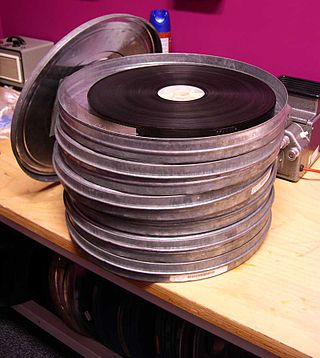
A film can is the light-tight container used to enclose film stock. They are typically a circular box pressed from thin sheet metal, but plastic examples are also used. Film cans are used to hold unexposed film, exposed film ready for developing and also for the distribution of completed film prints. The last of these does not require the can to be light-tight, but environmental protection and exclusion of dust makes a similar container just as useful.























